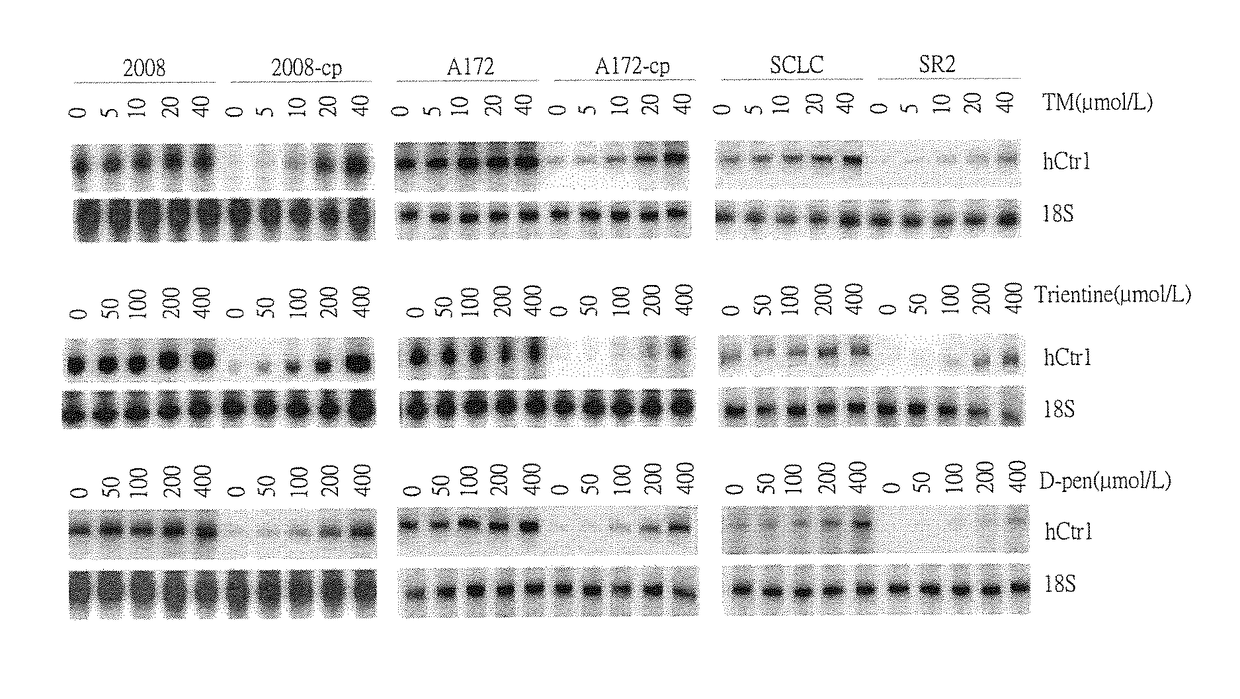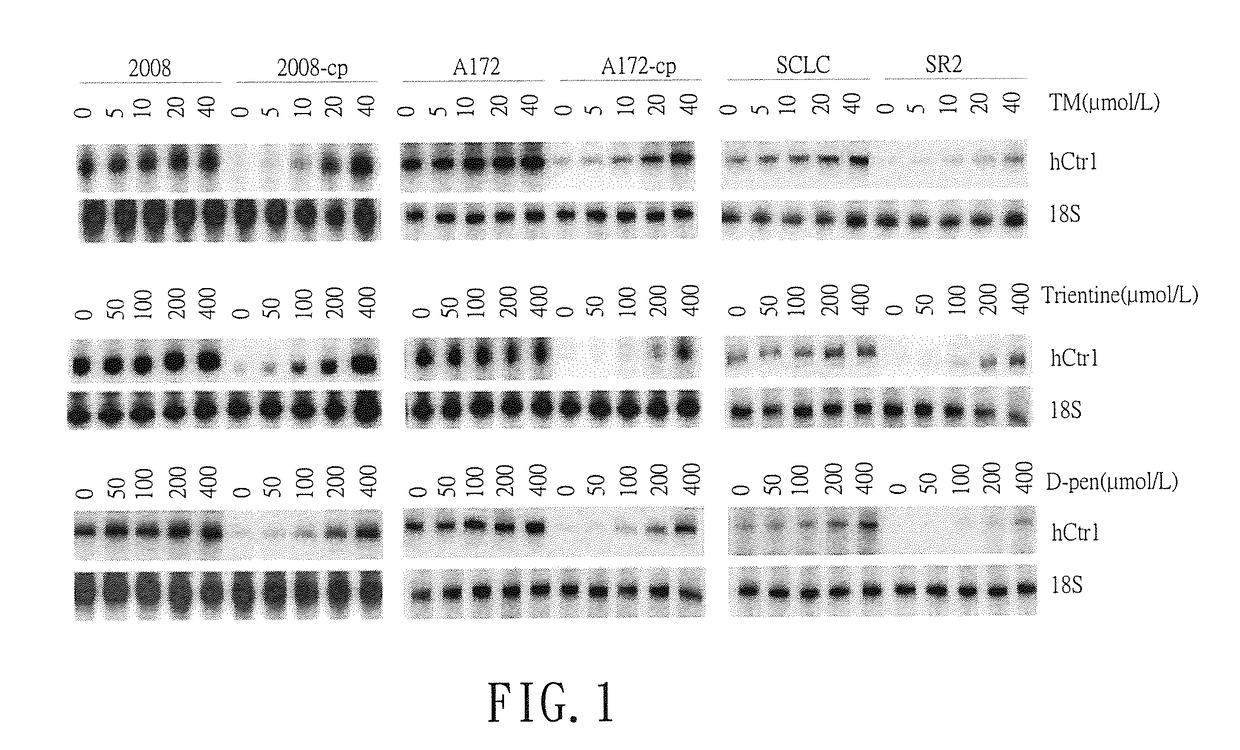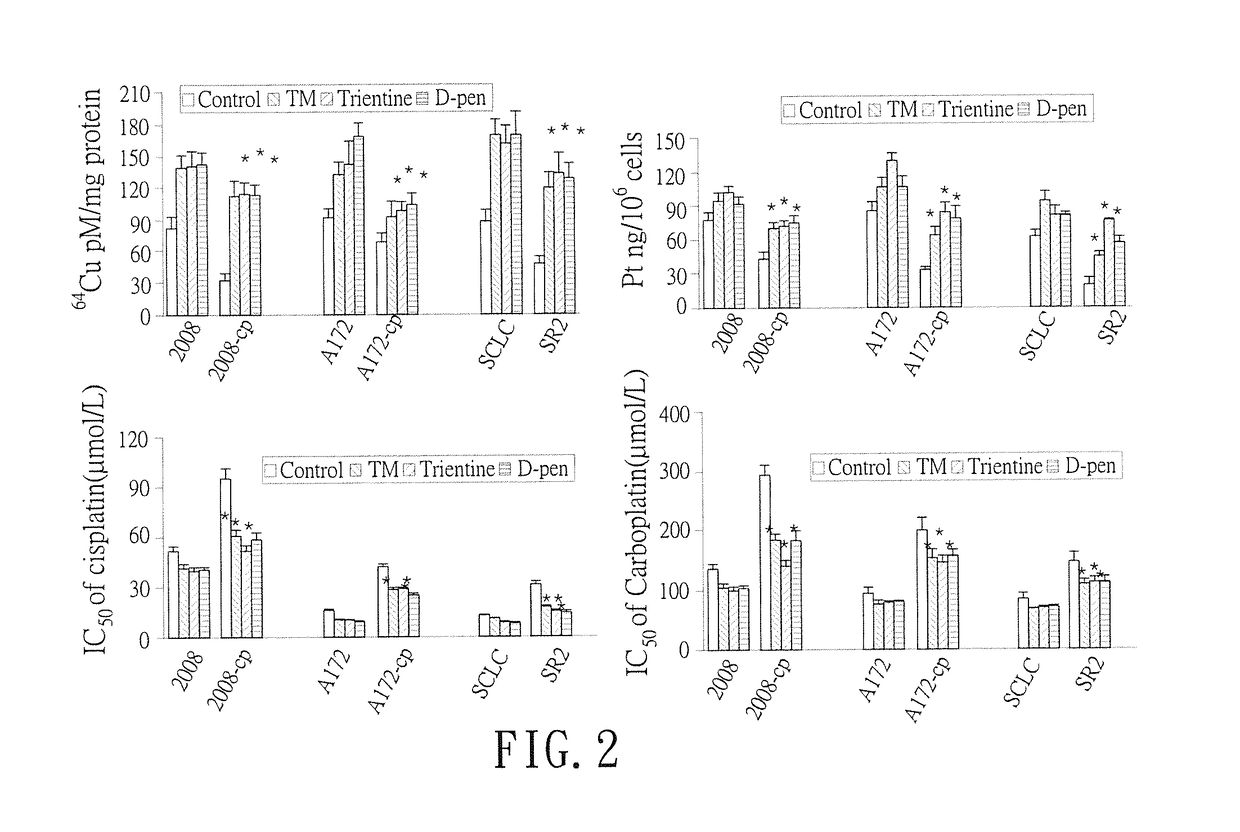Method of treating ovarian, tubal and peritoneal cancer
a technology for peritoneal cancer and ovarian tubes, applied in the field of ovarian, tubal and peritoneal cancer treatment, can solve the problems of low treatment efficacy, high mortality rate, and inability to enhance the treatment efficacy of second-line drugs, so as to achieve effective treatment of ovarian, tubal and peritoneal cancer, and promote entry.
- Summary
- Abstract
- Description
- Claims
- Application Information
AI Technical Summary
Benefits of technology
Problems solved by technology
Method used
Image
Examples
example 1
ression in Chemoresistant and Chemosensitive Cell Lines
[0029]The cell lines used in this study were obtained from the following sources: ovarian cancer cell lines 2008 and 2008-cp from Dr. Z. Siddik (MD Anderson Cancer Center, Houston, Tex.), human glioblastoma cell lines A172 and A172-Cp from Dr. A. Gomi (Jichi Univ., Tokyo, Japan), small cell lung cancer cell lines SCLC and SR2 from N. Savaraj, (Univ. Miami). Three pairs of cisplatin (Cp) resistant cell lines (cDDPR) (2008-cp, A172-cp and SR2) and their matched parental cells (2008, A172 and SCLC) were treated with different concentrations of three different copper chelators (Cu depletors), tetrathiomolybdate (TM) (0, 5, 10, 20 and 40 μmol / L), trientine (0, 50, 100, 200 and 400 μmol / L) or D-penicillamide (D-pen) (0, 50, 100, 200 and 400 μmol / L). Cisplatin (Cp), carboplatin, oxaliplatin, tetrathiomolybdate (TM), trientine, and D-penicillamide (D-pen) were obtained from Sigma-Aldrich (St Luis, Mo.). The hCTR1 expression levels were ...
example 2
elator and Platinum-Based Chemotherapeutic Agent Act Synergistically to Inhibit Tumor Growth
[0033]Female athymic NCR nu / nu-nude mice (aged 5 weeks, weight ˜20 grams) were purchased from the National Cancer Institute-Frederick Cancer Research and Development Center (Frederick, Md.) and housed in a pathogen-free environment. Animal care followed the guidelines of the Association for Assessment and Accredition of Laboratory Animal Care. The animal protocol was approved by the MDACC Institutional Animal Care and Use Committee.
[0034]The animals were inoculated subcutaneously with 5×106 cancer cells on the dorsal lumbosacral region. About one month later, when the tumor volumes reached 150-250 mm3, the animals were randomly divided into four groups with four animals per group and the treatments were initiated: the first group (control) was treated with 100 μl of 0.85% NaCl solution by gavage. The second group (D-pen) was treated with 100 μl of 400 mM D-pen (in 0.85% NaCl) by daily gavage ...
example 3
nregulates the Expression of hCTR1 and SP1
[0038]It is well known that FOXM1 is required for cell cycle progression, apoptosis, angiogenesis, and DNA damage repair. In addition, FOXM1 plays a critical role of the maintenance of stem cell pluripotency. For instance, aberrant expression of FOXM1 is linked to tumorigenesis and chemoresistance. Accordingly, effects of FOXM1 on hCTR1 and SP1 in Ad293 cells expressing vector alone (pcDNA), vector encoding FOXM1, control siRNA (siControl), or FOXM1 siRNA (siFOXM1) were measured herein by Western blots. β-ACTIN was used as an internal control.
[0039]Cell lysates were harvested in ice-cold modified radioimmune precipitation assay buffer containing a protease inhibitor Cocktail™ (Roche). Lysates normalized for amount protein were separated on 10% SDS-polyacrylamide gels and electrophoretically transferred to nitrocellulose (Hybond™-P PVDF transfer membranes; Amersham Biosciences). After incubation with primary antibodies to FOXM1, SP1 or hCTR1 ...
PUM
| Property | Measurement | Unit |
|---|---|---|
| weight | aaaaa | aaaaa |
| volumes | aaaaa | aaaaa |
| volumes | aaaaa | aaaaa |
Abstract
Description
Claims
Application Information
 Login to View More
Login to View More - R&D
- Intellectual Property
- Life Sciences
- Materials
- Tech Scout
- Unparalleled Data Quality
- Higher Quality Content
- 60% Fewer Hallucinations
Browse by: Latest US Patents, China's latest patents, Technical Efficacy Thesaurus, Application Domain, Technology Topic, Popular Technical Reports.
© 2025 PatSnap. All rights reserved.Legal|Privacy policy|Modern Slavery Act Transparency Statement|Sitemap|About US| Contact US: help@patsnap.com



